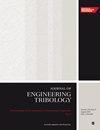Numerical simulation and experimental study on pitting damage of IN625 laser cladding layer
IF 1.8
3区 工程技术
Q3 ENGINEERING, MECHANICAL
Proceedings of the Institution of Mechanical Engineers, Part J: Journal of Engineering Tribology
Pub Date : 2023-09-04
DOI:10.1177/13506501231197877
引用次数: 0
Abstract
The IN625 laser cladding is extensively utilized in the sectors of aviation, navigation, petroleum, and chemical engineering, among others. When the cladding layer is exposed to harsh environments for extended periods, it is prone to fatigue delamination, pitting corrosion, and other detrimental effects, which jeopardize the performance of the workpiece. Quantitatively elucidating the corrosion failure mechanisms of the cladding layer can provide essential insights for enhancing its service life. This study focuses on investigating the evolution mechanism of pitting corrosion pits on the surface of the cladding layer in a corrosive environment. A numerical model for pitting corrosion in the IN625 cladding layer is established to reveal the transient variations in corrosion rate and electrode potential. The results indicate that the concentration changes of Cl − , Na + , and Ni 2+ in the corrosion pits follow the sequence of Cl − > Ni 2+ > Na + . The pH value in the corrosion pits gradually decreases from the top to the bottom, while the corrosion rate at the top of the pits exhibits minimal variation. As the corrosion rate increases, the pits continue to deepen. Based on electrochemical corrosion experiments conducted on the CS310 M electrochemical workstation between the substrate and the cladding layer, it is determined that the corrosion current density of the IN625 cladding layer is reduced by two orders of magnitude compared to the QT600 substrate, resulting in a 395.5-fold decrease in the corrosion rate. The IN625 cladding layer significantly enhances the corrosion resistance of the substrate.IN625激光熔覆层点蚀损伤的数值模拟与实验研究
IN625激光熔覆广泛应用于航空、航海、石油、化工等领域。当熔覆层长时间暴露在恶劣环境中时,容易产生疲劳脱层、点蚀等不利影响,危及工件的性能。定量地阐明熔覆层的腐蚀失效机理,对提高熔覆层的使用寿命具有重要意义。本研究重点研究了在腐蚀环境下熔覆层表面点蚀坑的演变机理。建立了IN625熔覆层点蚀的数值模型,揭示了熔覆层腐蚀速率和电极电位的瞬态变化。结果表明:腐蚀坑中Cl−、Na +和Ni 2+的浓度变化顺序为Cl−>Ni 2+ >Na +。腐蚀坑内的pH值从顶部到底部逐渐降低,而腐蚀坑顶部的腐蚀速率变化最小。随着腐蚀速率的增加,凹坑继续加深。在基材与熔覆层之间的CS310 M电化学工作站进行电化学腐蚀实验,确定IN625熔覆层的腐蚀电流密度比QT600基材降低了2个数量级,腐蚀速率降低了395.5倍。IN625包层显著提高了基体的耐蚀性。
本文章由计算机程序翻译,如有差异,请以英文原文为准。
求助全文
约1分钟内获得全文
求助全文
来源期刊

CiteScore
4.20
自引率
5.00%
发文量
110
审稿时长
6.1 months
期刊介绍:
The Journal of Engineering Tribology publishes high-quality, peer-reviewed papers from academia and industry worldwide on the engineering science associated with tribology and its applications.
"I am proud to say that I have been part of the tribology research community for almost 20 years. That community has always seemed to me to be highly active, progressive, and closely knit. The conferences are well attended and are characterised by a warmth and friendliness that transcends national boundaries. I see Part J as being an important part of that community, giving us an outlet to publish and promote our scholarly activities. I very much look forward to my term of office as editor of your Journal. I hope you will continue to submit papers, help out with reviewing, and most importantly to read and talk about the work you will find there." Professor Rob Dwyer-Joyce, Sheffield University, UK
This journal is a member of the Committee on Publication Ethics (COPE).
 求助内容:
求助内容: 应助结果提醒方式:
应助结果提醒方式:


